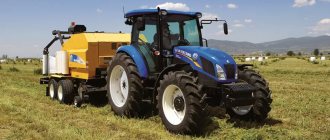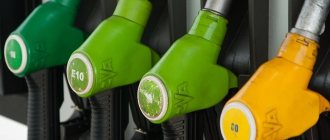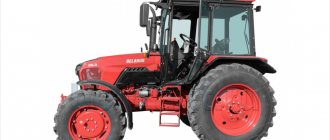Fuel consumption rates per engine hour for diesel engines
Diesel fuel consumption standards for special equipment are on average 5.5 liters per 1 hour of operation in simple transport mode. When excavating soils in the first or second degree, the consumption is reduced to 4.2 liters per 1 hour of work.
If you additionally load or unload these soils, then for all MTZ-based excavators the consumption will be equal to 4.6 liters per 1 hour of operation.
Necessary. Calculation of fuel consumption of a diesel forklift.
Calculation of fuel consumption of a diesel forklift
When purchasing a diesel forklift, the client may be interested in the fuel consumption of the forklift. This is due to the fact that the loader must be put on the balance sheet, fuel must be written off in accordance with standards, and the cost of goods and work must be calculated. Manufacturers in the technical specifications of diesel forklifts show “specific fuel consumption,” which is measured in grams per unit of power (hp or kW).
It is possible to calculate the large theoretical fuel consumption using the formula:
N—engine power;
q—specific fuel consumption;
Q is the large theoretical fuel consumption in grams per 1 hour of engine operation at high power.
For example, if the technical specifications of the loader included the following parameters:
Rated engine power, kW. (hp), not less: 59 (80)
Specific fuel consumption g/kW. h (g/l.s.h) no more than: 265 (195)
then in 1 hour of operation the loader would consume 265 * 59 = 15635 grams of fuel.
When calculating actual fuel consumption. two amendments must be taken into account:
1. The loader engine does not work all the time at high speeds with high power,
2. In most cases, fuel is recorded in liters, not grams.
Based on this, to calculate the current fuel consumption of the forklift, use the improved formula:
q—specific fuel consumption;
N - power, hp (kW);
R—density of diesel fuel (0.85 kg/dm3);
k1 is a coefficient characterizing the percentage of operating time at high engine speed;
Q - fuel consumption in liters per hour.
Since in practice the forklift is not loaded to its maximum during the shift, the engine of the forklift does not run at its own high power all the time, but the power varies depending on the load. This makes it necessary to apply a coefficient that would take into account the ratio of the engine operating time at high speeds to the engine operating time at minimum speeds. If there is no reliable data on the operation of the loader, it is assumed that out of 100% of the working time, only 30% of the machine works at high speeds, based on this, k1 will be equal to 70%: 30% = 2.33.
An example of calculating fuel consumption in liters per hour for the D3900 engine.
Q = N*q/(1000*R*k1) = 59*265:(1000*0.85*2.33)=7.9 l/hour.
Ultimately, theoretical calculations of diesel fuel consumption will always be slightly higher than in practice, because in real conditions the loader works less and the load on the engine is correspondingly less than in test conditions.
According to domestic statistics, fuel consumption for the D3900 engine ranges from 4.5 l/hour to 7.5 l/hour, depending on the load.
How to calculate real gas mileage #1 auto tips
Interesting posts
Similar articles that you will probably be interested in:
In most cases, the technical specifications for other types of diesel and heavy equipment loaders indicate specific fuel consumption, which is expressed in...
Thus, fuel consumption indicators are affected by such parameters as specific consumption and power of a combustible engine, duration of working hours, while...
One of the main questions that forklift owners ask themselves is how to calculate fuel consumption. It goes without saying that in the summary table of characteristics...
Diesel boiler consumption During the operation of any construction projects, heating plays a key role. At the moment, wood stoves are slowly...
Added to Fuel consumption // 2 Comments Real reviews from owners about the fuel consumption of the Mazda 3: Mazda 3, manual, 1.6 In mixed mode...
Fuel and lubricant consumption standards
These tips were compiled on the basis of the order of the Ministry of Transport of the Russian Federation dated March 14, 2008 N AM-23-r On the introduction of methodological recommendations on standards...
The appearance of electric vehicles is without a doubt a breakthrough in the automotive industry, but no one is in a hurry to remove gas stations from the face of the earth; rather, on the contrary, the number of gas stations is growing every day. The reason is simple - most cars still run on fuel (gasoline, diesel fuel, gas, etc.) and this will not change very, very soon. Japanese, German, American, domestic, Korean manufacturers are in no hurry to change anything - they produce hundreds of thousands of gasoline cars because there is demand.
Fuel is an expensive thing; one car enthusiast even calculated that on average, “over the life” of one car, a driver spends as much money on fuel as the car itself costs. That is why it will be useful for everyone to know how to calculate the gasoline consumption of their vehicle, how to calculate the average fuel consumption, what factors this figure depends on, and whether it is possible to make the car more economical. In this article we will try to fully understand this issue once and for all, discarding all the contradictions that can often be observed on the Internet.
Pint
The conversion of the amount of fuel of a given type into tons of standard fuel is carried out using a coefficient equal to the ratio of the heat content of 1 kg of fuel of a given type. Large Economic Dictionary A unit of accounting for organic fuel, applicable for comparing the thermal value of different types of fuel. The program is designed to quickly convert liters of petroleum products into tons, as well as to calculate the cost of a liter based on prices per ton.
Formula for determining the weight of diesel fuel Pressure calculator
To convert mass flow into volume flow, it is necessary, in addition to the direct ratio of units of measurement, to also make a correction for the density of the substance. When accounting, storing and dispensing various technological and fuel liquids, bulk materials, very often there is a need to convert one unit of measurement into another.
| Gasoline brand | Density in kg/m3 |
| AI-92 | 735,0 |
| AI-95 | 750,0 |
| AI-98 | 776,5 |
Application: obtaining energy through metabolism
The energy density of this dish is high, as the bacon and eggs contain a high percentage of fat. Photo posted with permission of the author.
Food is a form of energy for the animal body
Energy is necessary for all living beings. It is produced during metabolism. This process is similar to burning fuel. Fire in the body does not burn, but similar to combustion, oxygen is needed to produce energy, and during this redox process water and carbon dioxide are released. This is why oxygen is necessary for all living organisms.
Energy in foods is found in carbohydrates and proteins (17 kJ/g), fats (38 kJ/g), and alcohol (30 kJ/g). Nutrients in food are metabolized into glucose, amino and fatty acids, after which the body converts them into energy that is easily absorbed by the body - the enzyme adenosine triphosphate (ATP). ATP moves throughout the body and carries energy to the cells that need this energy.
Traveling to Mount Kinabalu on the island of Borneo, Malaysia. Photo posted with permission of the author.
The specific heat of combustion for food is measured in joules per kilogram and also in calories per gram. The latter units are used more often. Typically this energy is measured in bomb calorimeters, where food is burned in a similar way to other fuels. This releases hydrocarbons and water, just like during metabolism.
Foods with a high specific heat of combustion, that is, those that release a greater amount of energy per unit mass of the product, are called high energy density
. With an increase in water and other low-calorie substances in the product, such as fiber, this density decreases. Fat, on the other hand, increases energy density because it contains more calories per gram than other food components. That is, the more fat there is in a product, the greater its specific heat of combustion by mass.
On polar expeditions, researchers and scientific staff typically work in harsh physical conditions, so they require approximately three times more energy than people under normal conditions.
Energy consumption under extreme conditions
When creating a menu for hikes and other trips where food is carried by hand or carried on dogs, mules, and other animals, it is necessary to know the specific heat of combustion of the products. The smaller it is, the more energy received from this food, people or animals spend on moving this food. This is especially significant if these trips are long. Of course, in such situations the nutritional value of the product is also taken into account. If there is water on the route, they try to take with them dry or specially dried foods for these purposes, since they weigh much less than regular ones.
Researchers who work in the Arctic and Antarctic often transport food and other necessities on dogs, or carry them themselves, so it is especially important for them to know the specific heating value of products. This is also important because they require at least three times more calories than people under normal conditions. In cold weather, the body uses a huge amount of energy to maintain a constant body temperature. In addition, during expeditions in the Arctic and Antarctic, people experience greater physical stress than under normal conditions; This explains the additional energy costs. For these reasons, high energy density foods are taken on expeditions, such as chocolate (which contains a lot of fat and carbohydrates), butter, nuts and dried meat.
Some researchers believe that the 1912 Terra Nova expedition to the South Pole, led by Robert Falcon Scott, failed and five participants died because they incorrectly calculated the amount of calories they needed for each day and did not take with them enough food. It is also believed that they made a mistake with the choice of foods, choosing food with a specific heat of combustion lower than that of fat. So, they assumed that 4,500 calories a day should be enough, when in fact they burned about 6,000 calories or more. Although they ate butter, they did not stock up on high-energy-density foods in sufficient quantities, but instead consumed a lot of protein foods. As a result, the amount of calories in the food they had was not enough.
Camels store fat in their hump, and use it, as well as the water obtained during metabolism, during long treks in the desert.
Fat deposition as a way to store energy
Animals store fat and use it when they cannot get food. Fat metabolism produces water, which animals use when they do not have access to drinking water. Fat is also convenient because it has more energy per gram than other nutrients. Accordingly, the same amount of energy in fat is easier to tolerate as part of one's own body than other substances. Camels store fat in their hump, and as a result, as long as these reserves are sufficient, they always, even in the desert, have access to water and energy. The hump holds 15 to 20 kg of fat. Whales, seals, polar bears, and many other animals also have fat deposits for the same purposes.
Colony of northern elephant seals in Año Nuevo National Park in California
Researchers believe that people create energy reserves in the body by “storing fat.” Some theories about how this mechanism came about suggest that this way of storing energy in the body evolved through evolution in order to provide access to energy even when there is nothing to eat. Some also believe that women have a higher percentage of body fat because they were unable to hunt or gather food during pregnancy and caring for small children, so they needed larger fat reserves than men. This was especially important if the men could not get enough food for themselves, women and children, and ate it themselves. Now this is no longer necessary, but evolutionary adaptations change slowly, which is why people still store fat. This is believed to be one of the reasons for the obesity epidemic in many developed countries, where there is an abundance of cheap and easily accessible food.
You can slow down fat deposition and improve your metabolism by leading an active and healthy lifestyle.
Energy used by microorganisms and plants
Most animals obtain energy from the organic substances described above, that is, from fats, proteins and carbohydrates. Microorganisms, on the contrary, obtain energy from inorganic substances, such as ammonia, hydrogen, sulfides and iron oxide. Plants use solar energy, converting it into chemical energy through photosynthesis. Just like during metabolism in animals, the process of photosynthesis and the metabolism of microorganisms produces the substance ATP, which is directly used by plants and microorganisms as energy.
Standards for fuel and lubricants and waybills
There are special standards for fuels and lubricants (fuels and lubricants), and these standards have only a legal meaning and have no relation to the numbers indicated in the vehicle’s operating manual.
According to fuel and lubricants standards, operational fuel consumption must take into account such parameters as vehicle load, traffic density, climatic factors, road conditions and the use of additional electronics - air conditioning, heater, heated mirrors, etc.
These standards are necessary so that enterprises do not inflate their reported expenses on gasoline, but strive to use fuel and lubricants economically and pay taxes honestly. The indicators are also calculated in the waybill (fuel consumption rates are documented for each individual car). A waybill is a document that every driver of a commercial or government organization must have. The same applies to the consumption of diesel fuel for trucks.
Calculation of fuel consumption per 100 km (formula)
We have already described how to calculate fuel consumption per 100 km, and now we will try to reduce everything to a simpler and more understandable formula.
There are two formulas - one is simpler and more visual, allowing you to calculate fuel consumption based on the distance traveled on the odometer; the second – calculates the norm of fuels and lubricants. Let's look at both of them.
If S is the distance (in kilometers) that you covered on a full tank, and V is the volume of fuel (in liters) that was spent, then the consumption can be calculated as follows:
By multiplying this number by the price of gasoline and dividing by the distance, you can easily calculate the cost of 1 km of mileage.
The norm of fuels and lubricants can be calculated using this simple formula:
A = 0.01 B L K,
where A is the normalized flow rate;
B – basic norm;
L – vehicle mileage;
K – total correction factor.
Let us show with an example how to calculate the fuel consumption rate (gasoline consumption). To do this, let's consider the real situation in the city of Moscow - a Lada Kalina car, which has been working for the company for more than 5 years and, according to the waybill, its monthly mileage (distance, kilometer) is 1.8 thousand km. We find this car in the guidance document and see that the basic cost rate is 7.7 l./100 km. We look for correction coefficients in the tables:
- The population of Moscow is more than 3 million – 25% adjustment.
- The car is 5 years old, which means the adjustment for its service life is 5%.
The total coefficient is 30% greater, which means it is equal to 1.3. Substitute into the formula:
A = 0.01 · 7.7 · 1800 · 1.3 = 180.2 l.
Practice allows you to deviate by 10% from this number.
Thus, we can conclude that fuel consumption is an important value, knowing which, the driver will not only be able to more thoughtfully control his finances, but also has the opportunity to promptly detect a malfunction of tires, air filter, engine or other vehicle components.
By choosing the right driving style, optimal tires and periodically closing the windows, everyone can save fuel and reduce their fuel costs.
Happy travels to everyone, inexpensive fuel and favorable, aerodynamic, economical wind!
How to find out average fuel consumption (calculator)
Consumption refers to the amount of fuel that your car burns while covering a distance of 100 km. Of course, even within the same car the indicator can be completely different - outside the city we will get one figure, on smooth asphalt we will get a completely different one. The arithmetic mean of two, three, four, etc. fuel consumption and is the average consumption value.
This unit of measurement is the most reliable. Some believe that it makes sense to measure consumption as the volume of fuel burned per hour, but there are nuances that prevent this method from being seriously considered. It is completely unknown “what hour it was” and what distance the car traveled during this time. Was it a lightning-fast flight along the highway at cruising speeds or a slow, deliberate ride “with smoke breaks” off-road? The amount of fuel burned per unit of time is a convenient measurement system for sea and river transport, for airplanes and helicopters, but for a land passenger car or truck, the volume of fuel burned per hour, to put it mildly, does not mean anything.
There are a lot of special services that allow you to calculate fuel consumption online. As a rule, these calculators should include such indicators as the distance traveled, the amount of fuel consumed and, of course, the cost of fuel. As a result, the program displays the average fuel consumption and the approximate cost of one kilometer. To calculate, we suggest using this calculator:
Let's figure out how to calculate fuel consumption. This activity is quite interesting and many people do it in order to find out how true the automaker’s promises are.
How can this be done quickly, inexpensively and accurately? First, fill the tank full—full, right to the very top. Then you begin to set off along the highway. You drive, for example, 20 kilometers (you can completely use the road to work or home as a test - use your time and gasoline to your advantage). Then fill the tank full again, but this time pour fuel from a measuring canister to see how much is missing for a full tank.
For example, you got 1.6 liters. This means that this is exactly the amount of gasoline you needed to travel 20 km. ways. We get 1.6 l./20 km. Let's multiply both numbers by 5 and it comes out to 8 liters. / 100 km. This is your expense. Then conduct the same experiment on a country road. Now, for example, you have 0.9 liters. for 10 km. mileage Multiply both numbers by 10 and you get 9 l./100 km. Calculate the arithmetic average of the two indicators and you will get 8.5 l./100 km. This is the approximate average consumption.
The more tests you perform, the more accurate your average flow rate will be. Distance should be measured using the odometer, not a map or GPS.
Important to remember! Many people complain that traffic lights, other cars and small traffic jams interfere with the purity of the experiment, but this is not at all true - all these obstacles, on the contrary, create a real picture and allow us to obtain the fuel consumption that we are dealing with in reality.
General information
Camels use fat to obtain water from it.
Specific heat of combustion by mass
is energy measured relative to the mass of fuel burned. This article describes the energy obtained from the combustion of fuel and during metabolism in the body. For example, when a certain amount of hydrocarbon, such as propane, is burned, energy is released, which is measured as the specific heat of combustion. In the SI system, this quantity is measured in joules per kilogram, J/kg. The specific heat of combustion by mass is most often calculated for the heat obtained from the combustion of hydrocarbon fuels, although it can also be calculated from the combustion of any other fuel. Methane and butane are examples of hydrocarbons.
Oxygen is required for fuel combustion. Most often, oxygen from the surrounding air is used. During the combustion of fuel, heat is released, and water and carbon dioxide are by-products of combustion. Carbon dioxide is harmful to the environment, which is why energy from alternative sources, without the use of combustion, is being developed so widely. Water, on the other hand, is a useful by-product. Animals, such as camels, use fat not only as a source of energy, but also as an internal source of moisture necessary for the body, since its combustion produces water.
Factors affecting fuel consumption
Anyone who believes that fuel consumption depends only on horsepower, torque, and engine displacement are mistaken. These factors are important, but they are not sufficient.
Fuel consumption by car depends on:
- machine condition;
- fuel;
- driving style;
- climatic conditions;
- tires;
- aerodynamics.
Let's try to figure it out in more detail. Indeed, a lot depends on the condition of the car - a car during break-in requires more fuel, and an old car with a lot of faults requires even more.
Fuel. The type and quality of gasoline determines the rate of its combustion, the completeness of the fuel breakdown into components (some of the unused fuel can “fly away” into the exhaust) and much more. On the A95 and A98, the consumption is always slightly different.
Driving style is an individual concept and greatly influences consumption. The more measured and calm your driving style is, the more economical the car will be. For example, from the start, a driver “puts the pedal to the floor,” and the second driver in the same car makes a smooth start. Even if they initially had the same amount of gasoline, the reckless driver will stop earlier, and a calm driver will be able to travel a longer distance.
As for climatic conditions, the operating modes of the motor are very dependent on the ambient temperature. That is why it makes sense to separately calculate fuel consumption in the winter season. By including the resulting figure in the arithmetic average, you will get an even more accurate average consumption value.
Important to remember! In winter, the engine consumes more fuel than in summer.
When the conversation turns to tires, many drivers for some reason doubt that the type of tire can affect gas mileage. But in vain, since the influence is obvious. Do you know what fuel consumption the T-34 tank has? On average about 185 liters per 100 km. Yes, a terrible indicator! However, this is not only due to the fact that 19 horsepower is directed per ton of weight. The total area and mass of the track creates enormous traction and this consumes a lot of fuel. The situation is the same with tires: the smaller the mass of the tire and its surface area, the less gasoline is required to spin the crankshaft and, therefore, to turn the wheel.
civil Aviation
For the needs of civil aviation, another fuel consumption criterion is often used - grams per passenger kilometer
- Comparison of analogues of medium-haul passenger aircraft
Source:
[3]
| Tu-204 | Airbus A321 | Boeing 757-200 | Tu-154M | |
| Passenger capacity, persons | 212 | 199 | 216 | 176 |
| Maximum take-off weight, t | 107,5 | 89 | 108,8 | 102 |
| Maximum commercial load, t | 21 | 21,3 | 22,6 | 18 |
| Cruising speed, km/h | 850 | 900 | 850 | 950 |
| Required runway length, m | 2500 | 2500 | 2500 | 2300 |
| Fuel efficiency, g/pass.km | 19,3 | 18,5 | 23,4 | 27,5 |
| Cost, million dollars USA | 35 (2007) | 87-92 (2008) | 80 (2002) | 15 (1997) |
Measurement of specific heat of combustion
Specific heat of combustion can be measured in a calorimeter, an instrument designed to measure the heat generated. A bomb calorimeter is one such instrument, most commonly used to measure the energy produced by the combustion of fuel. It consists of: an isolated internal combustion chamber in which fuel is burned and which is sometimes called a bomb; devices for igniting fuel, mainly wire systems with an electric igniter; and a sealed outer chamber in which the water is heated. The temperature of this water is measured to determine the amount of energy released when the fuel burns.
In the USA and Canada, gasoline contains about 10% ethyl alcohol. The amount of energy in ethyl alcohol is approximately 33% lower than in “pure” gasoline. As a result, the distance traveled using such fuel is reduced by 3.3%.











